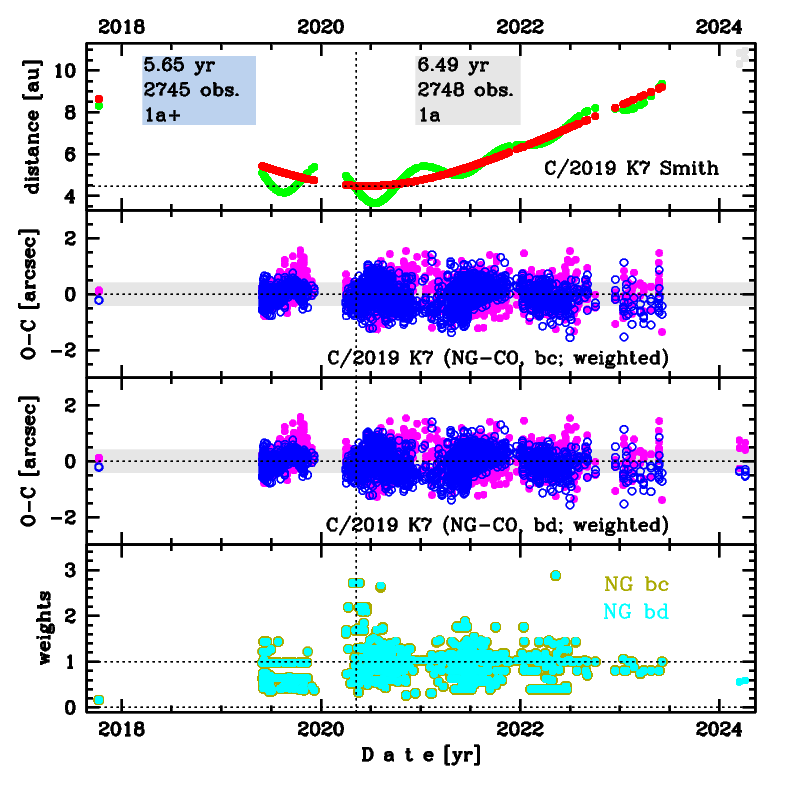C/2019 K7 Smith
more info
Comet C/2019 K7 was discovered on 30 May 2019, more than one year before its perihelion passage. Later a few pre-discovery observations were found from 8 and 9 October 2017. This comet was observed until 4 April 2024 (as in February 2025).
Comet had its closest approach to the Earth on 16 July 2020 (3.65 au), a month after its perihelion passage.
The preferred NG solution given here span over 6.49 yr in a range of heliocentric distances: 8.64 au – 4.48 au (perihelion) – 10.95 au; orbits based on pre-perihelion and post-perihelion data independently are also presented.
This Oort spike comet suffers moderate planetary perturbations during its passage through the planetary system that lead to a more tight future orbit with semimajor axis of about 2,500 au (see future barycentric orbit).
Comet had its closest approach to the Earth on 16 July 2020 (3.65 au), a month after its perihelion passage.
The preferred NG solution given here span over 6.49 yr in a range of heliocentric distances: 8.64 au – 4.48 au (perihelion) – 10.95 au; orbits based on pre-perihelion and post-perihelion data independently are also presented.
This Oort spike comet suffers moderate planetary perturbations during its passage through the planetary system that lead to a more tight future orbit with semimajor axis of about 2,500 au (see future barycentric orbit).
| solution description | ||
|---|---|---|
| number of observations | 2745 | |
| data interval | 2017 10 08 – 2023 06 03 | |
| data arc selection | some part of the available data set (ST2) | |
| range of heliocentric distances | 8.64 au – 4.48 au (perihelion) – 9.2 au | |
| type of model of motion | NC - non-gravitational orbits for symmetric CO-g(r)-like function | |
| data weighting | YES | |
| number of residuals | 5402 | |
| RMS [arcseconds] | 0.41 | |
| orbit quality class | 1a+ | |
| orbital elements (barycentric ecliptic J2000) | ||
|---|---|---|
| Epoch | 1715 12 17 | |
| perihelion date | 2020 06 16.77623233 | ± 0.00076038 |
| perihelion distance [au] | 4.46292024 | ± 0.00000583 |
| eccentricity | 0.99988853 | ± 0.00000476 |
| argument of perihelion [°] | 27.452332 | ± 0.000118 |
| ascending node [°] | 307.929034 | ± 0.000005 |
| inclination [°] | 103.522955 | ± 0.000018 |
| reciprocal semi-major axis [10-6 au-1] | 24.98 | ± 1.07 |
| file containing 5001 VCs swarm |
|---|
| 2019k7bc.bmi |

Upper panel: Time distribution of positional observations with corresponding heliocentric (red curve) and geocentric (green curve) distance at which they were taken. The horizontal dotted line shows the perihelion distance for a given comet whereas vertical dotted line — the moment of perihelion passage.
Middle panel(s): O-C diagram for a given solution (sometimes in comparison to another solution available in CODE), where residuals in right ascension are shown using magenta dots and in declination by blue open circles.
Lowest panel: Relative weights for a given data set(s).
Middle panel(s): O-C diagram for a given solution (sometimes in comparison to another solution available in CODE), where residuals in right ascension are shown using magenta dots and in declination by blue open circles.
Lowest panel: Relative weights for a given data set(s).
